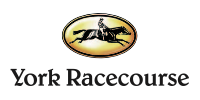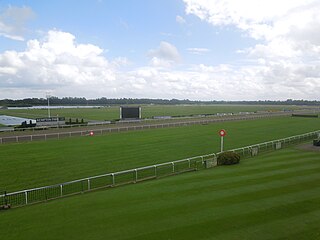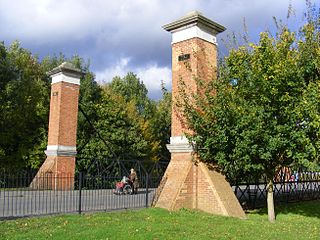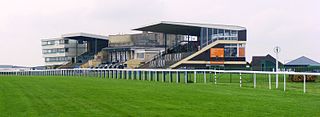
Ascot Racecourse is a dual-purpose British racecourse, located in Ascot, Berkshire, England, which is used for thoroughbred horse racing. It hosts 13 of Britain's 36 annual Flat Group 1 horse races and three Grade 1 Jumps races.

Aintree Racecourse is a racecourse in Aintree, Metropolitan Borough of Sefton, Merseyside, England, bordering the city of Liverpool. The racecourse is the venue for the Grand National steeplechase, which takes place annually in April over three days. Aintree also holds meetings in May and June, October (Sunday), November and December.

York Racecourse is a horse racing venue in York, North Yorkshire, England. It is the third biggest racecourse in Britain in terms of total prize money offered, and second behind Ascot in prize money offered per meeting. It attracts around 350,000 racegoers per year and stages three of the UK's 36 annual Group 1 races – the Juddmonte International Stakes, the Nunthorpe Stakes and the Yorkshire Oaks.
Leicester Racecourse is a horse racing course in Oadby, Leicestershire, about three miles south of the city centre.

Newmarket Racecourse is a British Thoroughbred horse racing venue in Newmarket, Suffolk, comprising two individual racecourses: the Rowley Mile and the July Course. Newmarket is often referred to as the headquarters of British horseracing and is home to the largest cluster of training yards in the country and many key horse racing organisations, including Tattersalls, the National Horseracing Museum and the National Stud. Newmarket hosts two of the country's five Classic Races – the 1,000 Guineas and 2,000 Guineas, and numerous other Group races. In total, it hosts 9 of British racing's 36 annual Group 1 races.

Kempton Park Racecourse is a horse racing track together with a licensed entertainment and conference venue in Sunbury-on-Thames, Surrey, England, 16 miles south-west of Charing Cross, London and on a border of Greater London. The site has 210 acres of flat grassland surrounded by woodland with two lakes in its centre. Its entrance borders Kempton Park railway station which was created for racegoers on a branch line from London Waterloo, via Clapham Junction.

Ayr Racecourse at Whitletts Road, Ayr, Scotland, was opened in 1907. There are courses for flat and for National Hunt racing.

Hurst Park Racecourse was a racecourse at Moulsey Hurst, West Molesey, Surrey, near the River Thames. It was first laid out in 1890 and held its last race in 1962.

Uttoxeter Racecourse is a National Hunt racecourse in Uttoxeter, Staffordshire, England.
Brighton Racecourse is an English horse racing venue located a mile to the northeast of the centre of Brighton, Sussex, owned by the Arena Racing Company.

Cartmel Racecourse is a small national hunt racecourse in the village of Cartmel, now in the ceremonial county of Cumbria, historically in Lancashire. Nine racedays are held each year, starting on the Whit Holiday weekend at the end of May and ending on the August Bank Holiday weekend in August Bank Holidays.

Bath Racecourse is a thoroughbred horse racing venue on Lansdown Hill, about 3+1⁄4 miles (5.2 km) northeast of Bath, Somerset, England. It is owned and operated by Arena Racing Company.
Chepstow Racecourse is a thoroughbred horse racing course located just north of the town of Chepstow in Monmouthshire, Wales, near the southern end of the Wye Valley and close to the border with England. It is one of 16 racecourses operated by the Arena Racing Company and is home of the richest race in Wales, the Coral Welsh Grand National.

Folkestone Racecourse was a thoroughbred horse racing venue in southeast England, until it closed in 2012. It is located in Westenhanger, by junction 11 of the M20 motorway and about two miles west of Folkestone. The course remains closed and all running rail and steeplechase fences have been removed. In May 2016 it was revealed that the land covered by the racecourse forms part of a plan to develop and build housing. It is now unkempt and in a state of disrepair.
Sedgefield Racecourse is an English left-handed horse racing course, used for jump racing. It is owned by Arena Racing Company and located close to the town of Sedgefield, County Durham.

Wolverhampton Racecourse is a thoroughbred horse racing venue located in Wolverhampton, West Midlands, England. The track was the first to be floodlit in Britain and often holds meetings in the evening. The track surface has been Tapeta since 2014.

Lincoln Racecourse is a former horse racing venue to the west of the city of Lincoln, at Carholme, a flat tract of common land, Lincolnshire, England. It was the original location of the Lincolnshire Handicap. The course closed in 1964, and the following year the race relocated to Doncaster Racecourse where a small change to the race title sees it run as the Lincoln Handicap.

Manchester Racecourse was a venue for horse racing located at a number of sites around the Manchester area including; Kersal Moor, New Barnes, Weaste and Castle Irwell, Pendleton, then in Lancashire. The final home of the course, Castle Irwell, was closed in 1963. Despite its name, the course was never actually located within the boundaries of the ancient township of Manchester or the subsequent city of Manchester.

Bromford Bridge Racecourse was a racecourse in the Bromford area of Birmingham, England. Its official name was 'Birmingham'. It staged flat and national hunt racing.

Alexandra Park Racecourse, known to Londoners as Ally Pally, was a horse racing venue in Alexandra Park, London; it was colloquially known as the Frying Pan on account of its shape. It opened on 30 June 1868 and closed 102 years later on 8 September 1970. It is now incorporated into the park, with a sports pitch in the centre of the racetrack oval.
















